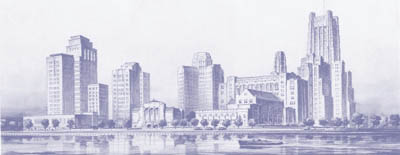
 |
|
|
 
While Northwestern's Evanston campus grew slowly over many years, the creation of the University's Chicago campus occurred remarkably quickly. In the University's early days, the loosely affiliated professional schools -- medicine, law, pharmacy and dental -- were located at various places in Chicago. In 1902 the law, pharmacy and dental schools moved to the Northwestern University Building at Lake and Dearborn Streets, a building that previously had been the Tremont House Hotel. Although the medical school remained on the Near South Side of Chicago, the large building on Lake provided a central location for most of Northwestern's professional programs -- as well as a large space for a dental clinic. In 1921 Northwestern purchased approximately 8.5 acres of land for $1.5 million on Chicago Avenue and Lake Shore Drive in the city's Streeterville neighborhood. Additional land was acquired in the following years, and the Chicago campus now encompasses approximately 30 acres. The construction of the new campus was a huge undertaking in an area of Chicago that was almost completely undeveloped and had a somewhat unsavory reputation. But the University embarked on a major fundraising campaign, and donors to the project included some of Chicago's most prominent citizens of that era, such as the Montgomery Ward and William A. Wieboldt families. The names of the Gothic-style buildings for the medical and dental schools (Ward, 1926), the business school (Wieboldt, 1926) and the law school (Levy Mayer, 1926), reflected that. After Passavant Hospital decided to locate on the site, many other medical buildings followed that are now an integral part of the Chicago campus. University architect James Gamble Rogers drew up a plan for the Chicago campus that has proven to be remarkably prescient. In addition to the three main buildings -- Ward, Wieboldt and Levy Mayer -- Rogers' campus plan left room for additions to them all, as well as the construction of several other structures. Although the Depression slowed construction for nearly a decade, both Thorne Hall (1932), a large auditorium that has since been demolished, and Abbott Hall (1940), a residence hall, were added in that time period. Since World War II, the Chicago campus has changed dramatically, particularly because of the construction of several large hospital buildings in the area. The University, however, constructed many of the additional buildings originally envisioned by Rogers. They include Morton (1955), Searle (1965) and the Health Sciences (1979) buildings, along with the Tarry Research and Education Building (1990) for the medical school and McCormick Hall (1962) and the Rubloff Building (1982) for the law school. This year, Northwestern will begin work on The Robert H. Lurie Medical Research Center, a high-tech medical research facility with space for laboratories and offices in the fields of genetics and molecular medicine, cancer, neurosciences, bioengineering and advanced medicine. A $40 million gift from Ann Lurie, a member of Northwestern's Board of Trustees, and a $30 million commitment from the state of Illinois helped provide initial funding for the $200 million structure. Other funding included an investment of $30 million from Northwestern Memorial Hospital and a $25 million anonymous gift from an alumnus. The 12-story building will be located at the corner of Superior Street and North Fairbanks Court, where the Passavant building stood. -- A.K.C |
||||||